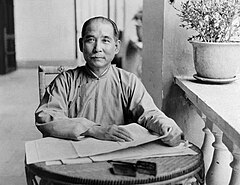 Global Information
Global Information1911 Revolution information
| 1911 Revolution 辛亥革命 | |||||||
|---|---|---|---|---|---|---|---|
| Part of the anti-Qing movements | |||||||
 Nanjing Road (Nanking Road) in Shanghai after the Shanghai Uprising, hung with the Five Races Under One Union flags then used by the revolutionaries in Shanghai and Northern China. | |||||||
| |||||||
| Belligerents | |||||||
|
|
Separatists
| ||||||
| Commanders and leaders | |||||||
|
| ||||||
| Strength | |||||||
| 200,000 |
100,000 Unknown | ||||||
| Casualties and losses | |||||||
| ~170,000 |
~50,000 Unknown | ||||||
| 1911 Revolution | |||||||||||||||||||||||||||
|---|---|---|---|---|---|---|---|---|---|---|---|---|---|---|---|---|---|---|---|---|---|---|---|---|---|---|---|
"Xinhai Revolution" in Chinese characters | |||||||||||||||||||||||||||
| Chinese | 辛亥革命 | ||||||||||||||||||||||||||
| Literal meaning | "Xinhai (stem-branch) revolution" | ||||||||||||||||||||||||||
| |||||||||||||||||||||||||||
| Part of the Politics series |
| Republicanism |
|---|
|
|
The 1911 Revolution, also known as the Xinhai Revolution or Hsinhai Revolution, ended China's last imperial dynasty, the Qing dynasty, and led to the establishment of the Republic of China. The revolution was the culmination of a decade of agitation, revolts, and uprisings. Its success marked the collapse of the Chinese monarchy, the end of 2,132 years of imperial rule in China and 276 years of the Qing dynasty, and the beginning of China's early republican era.[2]
The Qing dynasty had struggled for a long time to reform the government and resist foreign aggression, but the program of reforms after 1900 was opposed by conservatives in the Qing court as too radical and by reformers as too slow. Several factions, including underground anti-Qing groups, revolutionaries in exile, reformers who wanted to save the monarchy by modernizing it, and activists across the country debated how or whether to overthrow the Qing dynasty. The flash-point came on 10 October 1911, with the Wuchang Uprising, an armed rebellion among members of the New Army. Similar revolts then broke out spontaneously around the country, and revolutionaries in all provinces of the country renounced the Qing dynasty. On 1 November 1911, the Qing court appointed Yuan Shikai (leader of the powerful Beiyang Army) as Prime Minister, and he began negotiations with the revolutionaries.
In Nanjing, revolutionary forces created a provisional coalition government. On 1 January 1912, the National Assembly declared the establishment of the Republic of China, with Sun Yat-sen, leader of the Tongmenghui (United League), as President of the Republic. A brief civil war between the North and the South ended in compromise. Sun would resign in favor of Yuan Shikai, who would become President of the new national government, if Yuan could secure the abdication of the Qing emperor. The edict of abdication of the six-year-old Xuantong Emperor, was promulgated on 12 February 1912. Yuan was sworn in as president on 10 March 1912.
In December 1915, Yuan restored the monarchy and proclaimed himself as the Hongxian Emperor, but the move was met with strong opposition from the population and the Army, leading to his abdication in March 1916 and the reinstatement of the Republic. Yuan's failure to consolidate a legitimate central government before his death in June 1916 led to decades of political division and warlordism, including an attempt at imperial restoration of the Qing dynasty.
The revolution is named Xinhai because it occurred in 1911, the year of the Xinhai (辛亥) stem-branch in the sexagenary cycle of the traditional Chinese calendar.[3] The Republic of China on the island of Taiwan and the People's Republic of China (PRC) in mainland China both consider themselves the legitimate successors to the 1911 Revolution and honor the ideals of the revolution including nationalism, republicanism, modernization of China and national unity. 10 October is the National Day of the Republic of China on Taiwan, and the Anniversary of the 1911 Revolution in the PRC.
| Part of a series on |
| Political revolution |
|---|
 |
|
|
| Part of a series on |
| Three Principles of the People |
|---|
 |
|
- ^ Kit-ching (1978), pp. 49–52.
- ^ Li, Xiaobing. (2007). A History of the Modern Chinese Army. University Press of Kentucky. ISBN 0-8131-2438-7, ISBN 978-0-8131-2438-4. pp. 13, 26–27.
- ^ Li, Xing (2010). The Rise of China and the Capitalist World Order. Ashgate Publishing Ltd. p. 91. ISBN 978-0-7546-7913-4., ISBN 978-0-7546-7913-4